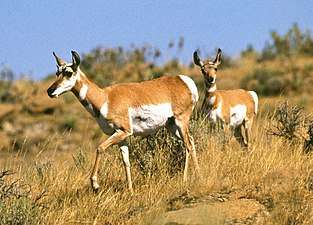Pecora
Pecora is an infraorder of even-toed hoofed mammals with ruminant digestion (Ruminantia, a clade within the Artiodactyla). Most members of Pecora have cranial appendages projecting from their frontal bones; only two extant genera lack them, Hydropotes and Moschus.[2] The name “Pecora” comes from the Latin word pecus, which means “horned livestock”.[3] Although most pecorans have cranial appendages, only some of these are properly called “horns”, and many scientists agree that these appendages did not arise from a common ancestor, but instead evolved independently on at least two occasions.[2][3][4][5] Likewise, while Pecora as a group is supported by both molecular and morphological studies, morphological support for interrelationships between pecoran families is disputed.[2]
| Pecora | |
|---|---|
 | |
| Pronghorn | |
| Scientific classification | |
| Kingdom: | Animalia |
| Phylum: | Chordata |
| Class: | Mammalia |
| Order: | Artiodactyla |
| Suborder: | Ruminantia |
| Infraorder: | Pecora Flower, 1883[1] |
| Subgroups | |
| |
Evolutionary history
The first fossil ruminants appeared in the mid-Eocene and were small, likely omnivorous, forest-dwellers.[6] Artiodactyls with cranial appendages first occur in the early Miocene.[6] The appearance of Pecora during the Miocene suggests that its rapid diversification may correspond to the climate change events of that epoch.[6][7]
Taxonomy
Current attempts to determine the relationships among pecoran families (as well as all artiodactyls) rely on molecular studies, as little consensus exists in morphological studies.[2] Different families within Pecora are recognized as valid by different groups of scientists.[6]and sources therein, pp. 4–5
Infraorder Pecora ("horned ruminants", "higher ruminants")
- Family †Gelocidae
- Family †Hoplitomerycidae
- Family †Leptomerycidae
- Parvorder Giraffomorpha
- Family †Palaeomerycidae
- Superfamily Giraffoidea
- Family Giraffidae (giraffe, okapi)
- Family †Climacoceratidae
- Superfamily Cervoidea
- Superfamily Bovoidea
- Parvorder Giraffomorpha
Anatomy
Pecorans share characteristics with other artiodactyls, including a four-chambered stomach, and a paraxonic foot, meaning that it supports weight on the third and fourth digits. Several characteristics distinguish Pecora from its sister taxon, Tragulina: an astragalus with parallel sides, a loss of the trapezium, and differences in parts of the skull such as the petrosal bone.[4]
The distinguishing features of most pecoran families are cranial appendages. Most modern pecorans (with the exception of the Moschidae) have one of four types of cranial appendages: horns, antlers, ossicones, or pronghorns.[6]
- True horns have a bone core that is covered in a permanent sheath of keratin. They are indicative of Bovidae. Horns develop in the periosteum over the frontal bone, and can be curved or straight.[4] Surface features on the keratin sheath (e.g., ridges or twists) are thought to be caused by differential rates of growth around the bone core.[4]
- Antlers are bony structures that are shed and replaced each year in members of the family Cervidae. They grow from a permanent outgrowth of the frontal bone called the pedicle.[4] Antlers can be branched, as in the white-tailed deer (Odocoileus virginianus), or palmate, as in the moose (Alces alces).
- Ossicones are permanent bone structures that fuse to the frontal or parietal bones during the lifetime of an animal.[4] They are found only in the Giraffidae and closely related extinct clades,[4] represented in modern animals by the giraffe (Giraffa camelopardalis) and the okapi (Okapia johnstoni).
- Pronghorns are similar to horns in that they have keratinous sheaths covering permanent bone cores; however, these sheaths are deciduous and can be shed like antlers.[4] Very little is known about the development of pronghorns, but they are generally presumed to have evolved independently.[4] The only extant animal with pronghorns is the pronghorn antelope (Antilocapra americana).
References
- Flower, W. On the Arrangement of the Orders and Families of Existing Mammalia. Proceedings of the Zoological Society of London. 178 -186. 1883.
- Hassanin, A.; Douzery, E. (2003). "Molecular and Morphological Phylogenies of Ruminantia and the Alternative Position of the Moschidae". Systematic Biology. 52 (2): 206–228. doi:10.1080/10635150390192726. PMID 12746147.
- Bubenik, A. Epigenetical, Morphological, Physiological, and Behavioral Aspects of Evolution of Horns, Pronghorns, and Antlers. in Horns, Pronghorns, and Antlers. G. Bubenik and A. Bubenik eds. Springer-Verlag. New York. 1990
- Janis, C., K. Scott. The Interrelationships of Higher Ruminant Families with Special Emphasis on the Members of the Cervoidea. American Museum Novitates. 2893: 1-85. 1987. http://digitallibrary.amnh.org/dspace/handle/2246/5180
- Hassanin, A.; Delsuc, F.; Ropiquet, A.; Hammer, C.; Matthee, C.; Ruiz-Garcia, M.; Catzeflis, F.; Areskoug, V.; Nguyen, T. T.; Couloux, A. (2012). "Pattern and Timing of Diversification of Cetartiodactyla (Mammalia, Laurasiatheria), as Revealed by a Comprehensive Analysis of Mitochondrial Genomes". Comptes Rendus Biologies. 335 (1): 32–50. doi:10.1016/j.crvi.2011.11.002. PMID 22226162.
- DeMiguel, D.; Azanza, B.; Morales, J. (2014). "Key Innovations in Ruminant Evolution: A Paleontological Perspective". Integrative Zoology. 9 (4): 412–433. doi:10.1111/1749-4877.12080. PMID 24148672.
- Morales, J.; Pickford, M.; Soria, D.; Pachyostosis (1993). "Lorancameryx pachyostoticus Nov. Gen. Nov. Sp. and Its Bearing on the Evolution of Bony Appendages in Artiodactyls". Geobios. 26 (2): 207–230. doi:10.1016/S0016-6995(93)80016-K.